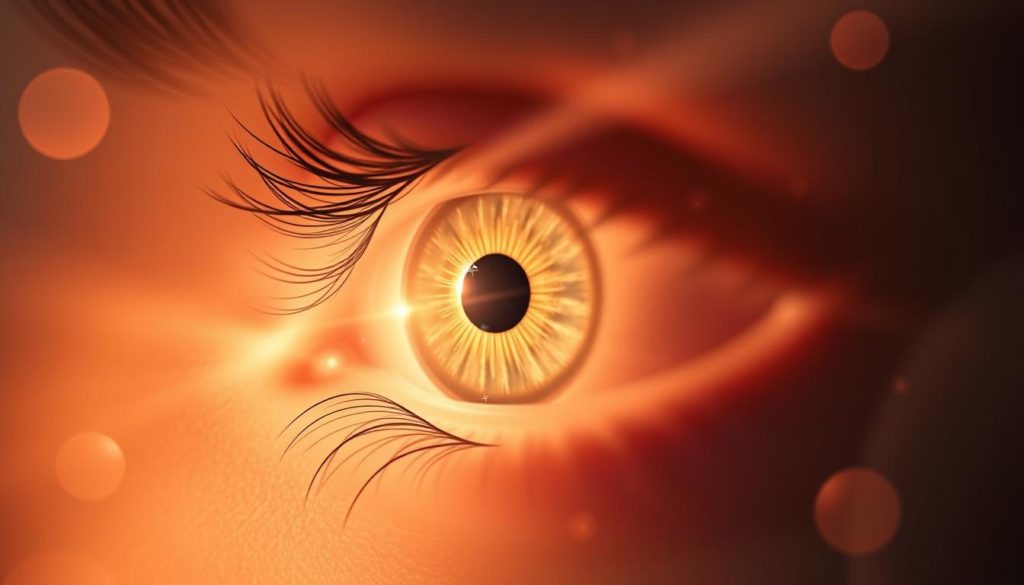“The only thing worse than being blind is having sight but no vision.” – Helen Keller
Aphakia is a condition where the lens in the eye is missing. It can happen due to surgery, injury, or genetics. This changes how people see the world.
Exploring aphakia, we look at its symptoms, causes, and how it affects vision. We aim to understand the medical side and the daily struggles of those with aphakia. Our goal is to offer a deep understanding and support in their journey to adapt to life without a lens.
What Is Aphakia?
Aphakia is a rare eye condition where the natural lens is missing. It can be present at birth or happen after surgery or injury. Knowing about an aphakic eye helps us understand its impact on vision.

Aphakia Definition
The aphakia definition means having no lens in one or both eyes. The lens is key for clear vision by focusing light on the retina. Without it, the eye can’t focus properly, causing blurry vision.
Understanding Aphakic Eye
An aphakic eye has unique traits. Vision can change, often leading to farsightedness and other vision problems. People with this no lens condition also face higher risks of eye issues like retinal detachment or glaucoma.
Studies show that without a lens, vision and eye health are affected. So, it’s important to understand and manage the aphakic eye to improve life quality for those affected.
Causes of Aphakia
Aphakia can happen for different reasons. It’s important to know why it occurs to prevent and manage it. This section will explore the main causes, including genetics, eye injuries, and surgery complications.

Genetic Factors
Genetic disorders often lead to aphakia. Some people are born without a lens or have lens defects. Studies show that genes play a big role, with certain mutations linked to aphakia.
Traumatic Events
Eye injuries from accidents or blows can also cause aphakia. Such injuries can badly damage the lens, requiring its removal. Fast medical care is key to saving vision.
Complications from Surgery
Cataract surgery is a common reason for aphakia. The surgery removes the lens to treat cataracts. Sometimes, problems arise that prevent a new lens from being put in, leading to aphakia. Despite medical progress, this risk remains.
| Cause | Description |
|---|---|
| Genetic Factors | Congenital conditions leading to the absence or removal of the lens. |
| Traumatic Events | Physical eye injury necessitating lens removal. |
| Complications from Surgery | Issues arising during cataract surgery that prevent lens replacement. |
Aphakia Symptoms
Aphakia symptoms can vary a lot from person to person. One common sign is blurred vision. This makes it hard to see things clearly at different distances.
Many people with aphakia also notice visual distortion
Glare sensitivity is another big issue. People often see halos and glare from bright lights. This can be really tough at night or in bright places.
Another symptom is losing the ability to focus naturally. This means people with aphakia often need glasses to see close-up. This can affect their near vision.
| Symptom | Description |
|---|---|
| Blurred Vision | Inability to see clearly at various distances. |
| Visual Distortion | Waviness or bending in the field of vision. |
| Glare Sensitivity | Increased sensitivity to bright lights and glare. |
| Loss of Focusing Ability | Difficulty focusing on close objects without corrective lenses. |
Patients share many different experiences with aphakia. Doctors see these symptoms a lot and use special treatments. They help each patient deal with their unique vision problems.
How Aphakia Affects Vision
Aphakia means the eye lacks a lens. This greatly affects how we see the world. It changes how light is focused, impacting daily tasks.
Impact on Visual Acuity
Without a lens, the eye can’t focus light well. This leads to severe vision problems. People with aphakia often see distant things better than close ones.
This makes everyday tasks hard. It’s tough to see things up close clearly.
Differences Between Aphakic and Normal Vision
Aphakic eyes are different from normal ones. Normal eyes focus light well, giving sharp vision. Aphakic eyes need help to see clearly.
They might use special lenses or surgery. Let’s look at these differences more closely.
| Aspect | Aphakic Vision | Normal Vision |
|---|---|---|
| Lens Presence | Absent | Present |
| Light Refraction | Blurred, unfocused | Sharp, focused |
| Visual Acuity | Reduced, hyperopic tendencies | Optimal, normal range |
| Corrective Measures | Essential (lenses, surgery) | Minimal or none |
These differences mean big changes for people with aphakia. They need special eye care and make big adjustments. This helps them deal with their vision problems.
Aphakia Diagnosis
Diagnosing aphakia requires a mix of techniques and tools. These help give a full view of the eye. An ophthalmic examination is key to spot this condition. Let’s look at the main methods and tools used for aphakia diagnosis.
Examination Techniques
The first step in an ophthalmic examination for aphakia is slit-lamp biomicroscopy. This method lets the eye doctor see the eye’s front part clearly. Retinoscopy is also important, as it checks the eye’s focus and finds any issues. Both are vital for diagnosing aphakia.
Tools Used in Diagnosis
Diagnosing aphakia uses advanced and precise tools. Ophthalmoscopes are key for looking at the retina and optic nerve. Corneal topographers and keratometers also play a big role. They check the cornea’s shape and curve. These tools help make a correct aphakia diagnosis.
| Examination Technique | Diagnostic Tool | Purpose |
|---|---|---|
| Slit-Lamp Biomicroscopy | Slit-Lamp | Detailed view of the eye’s anterior segment |
| Retinoscopy | Retinoscope | Detects refraction and irregularities |
| General Ophthalmic Examination | Ophthalmoscope | Examination of retina and optic nerve |
| Corneal Assessment | Topographer & Keratometer | Evaluates cornea’s curvature and shape |
Aphakia Treatment Options
There are many ways to treat aphakia, each suited to different needs and lifestyles. You can choose from traditional glasses to the latest in surgery.
Corrective Lenses
For a long time, glasses were the main treatment for aphakia. These glasses help make up for the missing lens. But, they can be heavy and hard to wear, especially if you need strong glasses.
Use of Contact Lenses
Contact lenses are a better choice for many. They give a wider view and don’t distort like thick glasses. But, you must take care of them to avoid eye problems.
Innovations in Treatment
New technology has brought more lasting solutions like lens implants. This surgery puts artificial lenses in your eye, just like your natural one. Studies show it works well for all ages.
| Aphakia Treatment Options | Pros | Cons |
|---|---|---|
| Corrective Eyewear | Non-invasive, Effective | Bulky, Distortion |
| Contact Lenses | Better Aesthetics, Wider Vision | Maintenance, Risk of Infection |
| Lens Implants | Permanent, Natural Vision | Surgical Risks, Cost |
Aphakia Surgery
Aphakia surgery uses different methods to fix vision without a natural lens. The goal is to make vision better after surgery and lower risks. This is important for complex procedures.
Types of Aphakia Surgery
There are many ways to fix aphakia. The choice depends on the patient’s needs and the surgeon’s skills. Here are some common surgeries:
- Secondary Intraocular Lens (IOL) Implantation: This puts an artificial lens in after a cataract is removed.
- Scleral Fixation IOL: This method attaches the IOL to the white part of the eye. It’s good for those without support.
Risks and Complications
Aphakia surgery has risks and complications. It’s important for patients to know these before surgery. Some big concerns are:
- Infection: Infection is a big risk after surgery. Keeping everything clean during and after surgery helps.
- Retinal Detachment: This serious problem can happen after surgery. It might need extra treatment to protect vision.
Research shows aphakia surgery can greatly improve vision. Following up with doctors and taking care of yourself after surgery is key for the best results.
| Procedure | Benefits | Risks |
|---|---|---|
| Secondary IOL Implantation | Restores Vision | Potential for Infection |
| Scleral Fixation IOL | Stable Lens Position | Risk of Retinal Detachment |
Living with Aphakia
Living with aphakia brings its own set of challenges. It requires making lifestyle changes to improve daily life. These changes often involve using visual aids and adjusting daily routines.
Daily Challenges and Adaptations
People with aphakia may struggle with depth perception and focusing. They need to use special glasses or contact lenses. Even simple tasks like reading or going up stairs can be harder.
Getting help from professionals is key. Vision therapists and occupational therapists can teach new skills. For example, using magnifying glasses for reading or software to enlarge text on screens.
Success Stories from Aphakic Individuals
There are many inspiring stories of people living with aphakia. Mary, a graphic designer, went back to work with the right tools and support. Her story shows how important it is to find solutions that work for you.
Mark’s story is another example of overcoming aphakia. After a traumatic event, he worked hard in rehab and with a vision therapist. Now, he encourages others by sharing his journey and the help he received.
These stories give hope and show the many ways to manage aphakia. They highlight the importance of personalized help and its impact on daily life.
Aphakic Lens Options
Aphakic patients need special lenses to see clearly. There are two main types: spectacle lenses and intraocular lenses (IOLs). Each has its own benefits, depending on the patient’s needs and health.
High-powered spectacle lenses are often used. They correct the vision problem caused by the missing lens. But, they can be heavy and don’t help with side vision.
Intraocular lenses are a newer option. They are implanted to replace the missing lens. There are many types, like monofocal and multifocal, to fit different needs. Studies show IOLs can lead to better vision and quality of life than glasses.
Choosing the right lens is important. It depends on the patient’s vision needs, eye health, and lifestyle. Talking to an eye doctor and looking at the latest lens data can help make the best choice.
FAQ
What is Aphakia?
Aphakia is when the eye’s natural lens is missing. This can happen due to genetic issues, eye injuries, or surgery problems. Without the lens, focusing light on the retina is hard.
What are the main causes of Aphakia?
The main reasons for aphakia are genetics, eye injuries, and surgery issues. These factors can mess up the lens’s position or structure.
What are the symptoms of Aphakia?
Symptoms include blurry vision, glare, and trouble focusing. These issues make daily tasks hard without help.
How does Aphakia affect vision compared to a normal eye?
Aphakia greatly affects vision by removing the lens. This leads to big differences in vision quality compared to normal eyes.
How is Aphakia diagnosed?
Diagnosis uses slit-lamp exams and retinoscopy. Ophthalmoscopes help doctors see the eye. These methods help spot aphakia.
What are the treatment options for Aphakia?
Treatments include glasses, contact lenses, and intraocular lens implants. The best option depends on age, lifestyle, and needs.
What types of surgeries are available for Aphakia?
There are surgeries like lens implantation and scleral fixated IOLs. But, these carry risks like infections or retinal detachment.
What challenges do people with Aphakia face in their daily lives?
Living with aphakia is tough. It means adapting to vision changes and using corrective devices. People share tips on managing aphakia and living well.
What lens options are available for Aphakic patients?
Aphakic patients have many lens choices, like high-powered glasses and IOLs. The right choice depends on vision loss, lifestyle, and doctor advice.


